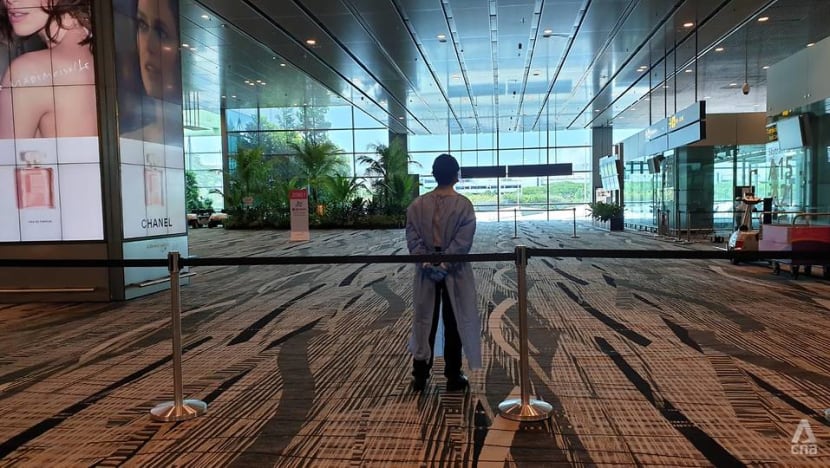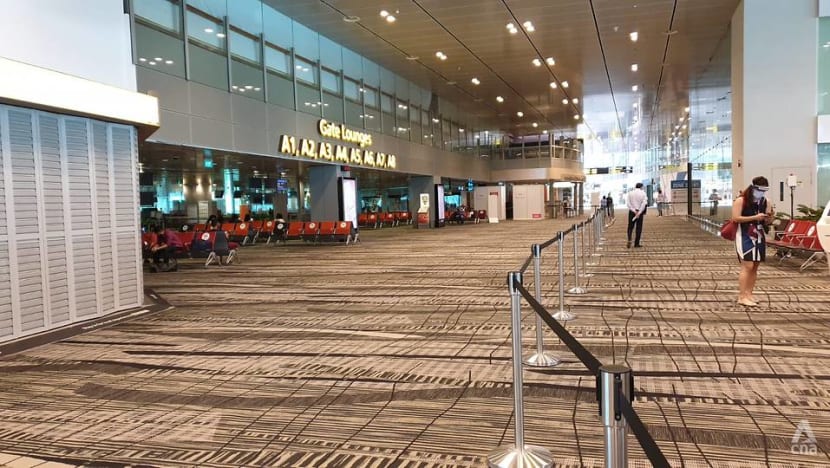14 COVID-19 cases who worked in highest-risk areas at Changi Airport visited Terminal 3 food court

A security staff member working in Zone 1 wearing full personal protective equipment at Changi Airport, May 24, 2021. (Photo: Gwyneth Teo)
SINGAPORE: Fourteen COVID-19 cases who worked in the highest-risk areas in Changi Airport had visited the food court at Terminal 3 for meals, said the Changi Airport Group on Monday (May 24).
The CAG announced on Monday that workers will be segregated based on their COVID-19 exposure risk and that only those who have been vaccinated will work in high-risk zones. This, among other measures, will be rolled out by Jun 14 when the airport reopens to the public.
READ: Changi Airport to segregate workers based on COVID-19 exposure risk
Zone 1 – the highest-risk zone – will include the terminal piers, the arrival immigration halls and baggage claim halls.
Of the workers who tested positive for COVID-19, 23 of them were working in the highest-risk areas that will be classified as Zone 1, said CAG officials in a briefing on Monday.
These areas were the "primary zone where the infection happened", a CAG spokesperson added.
At least 14 of the infected workers who worked in these areas had visited the food court at Terminal 3 for meals, according to investigations. They visited the food court at the "critical window" where community spread happened, said the CAG during the briefing.
“It is now quite clear that although there is a lot of attention on this food court, the food court is not the issue. It is a secondary source of infection," added the spokesperson.
Several days after they tested positive, a Victoria Junior College student and a landscaper with the National Parks Board were linked to the Changi Airport cluster, after it was found that they had visited the food court on the same day as other confirmed cases.
The food court was frequented on May 3 by two other cases in the Changi Airport cluster - a safety coordinator who worked at Terminal 3 and an aviation officer who worked at Terminals 1 and 3.
READ: VJC student who tested positive for COVID-19 is linked to Changi Airport cluster
READ: NParks landscaper who tested positive for COVID-19 linked to Changi Airport cluster
The food court, which was previously open to the public, will fall under Zone 3 in the new segregation system. Changi Airport is an active COVID-19 cluster, with 108 cases as of Sunday.
TRANSMISSION BETWEEN ZONES
Other zones were “relatively clean”, said the CAG. Investigations found that there were cases from a “very specific cluster” at the extreme left wing of a transit area, which will be part of Zone 2. There was mingling of staff members between Zone 1 and Zone 2, said CAG in the briefing.

“So we believe that this cluster was a secondary source of infection that came from Zone 1. And we know because the numbers are much smaller, and if this zone was inherently 'dirty', we would expect more cases and they would be dispersed in many areas," said the spokesperson.
A worker who assisted a family from South Asia last month could have been the infection source that led to some staff members testing positive, the CAG and Civil Aviation Authority (CAAS) said on Friday.
READ: Worker who assisted COVID-19-infected family from South Asia could be ‘source’ of 43 cases at Changi Airport
Similar to the spread of COVID-19 in the Zone 2 area, if Zone 3 had “more inherent problems”, there would have been “far more” positive cases linked to it, said the CAG.
“But this was not the case,” said a spokesperson in the briefing.
The airport has implemented “many layers of stringent safety protocols” since March last year, and these measures have “served us well” for the past 15 months, said CAG CEO Lee Seow Hiang.
“But clearly, something new has emerged with this variant, and the risk profile fundamentally shifted for our passenger operations. It has penetrated our defences and caused a community outbreak.”
BOOKMARK THIS: Our comprehensive coverage of the coronavirus outbreak and its developments
Download our app or subscribe to our Telegram channel for the latest updates on the coronavirus outbreak: https://cna.asia/telegram












